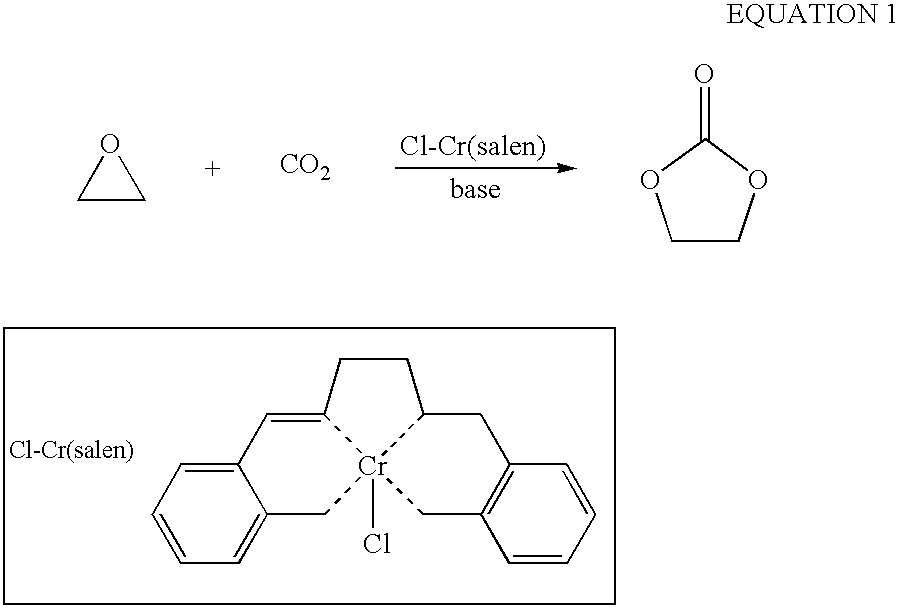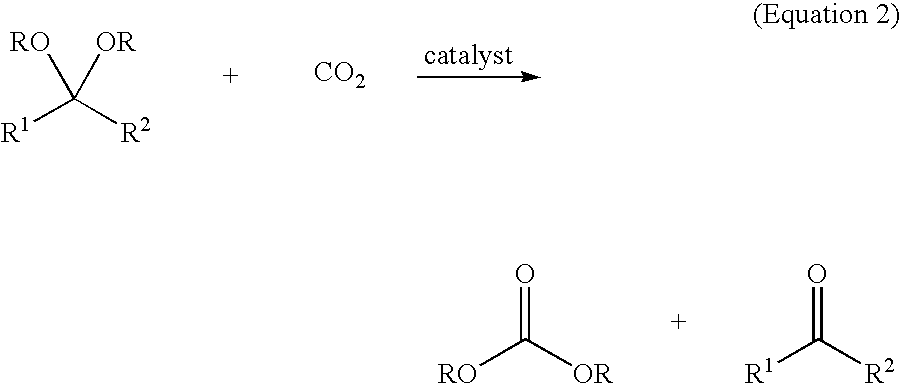Catalytic Composition for the Insertion of Carbon Dioxide Into Organic Compounds
a technology of organic compounds and carbon dioxide, which is applied in the field of catalytic compositions for the insertion of carbon dioxide into organic compounds, can solve the problems that the research conducted by the inventors has not revealed any precedent in the chemical literature on the reaction of acetals
- Summary
- Abstract
- Description
- Claims
- Application Information
AI Technical Summary
Benefits of technology
Problems solved by technology
Method used
Image
Examples
example 1
[0019]In a preferred embodiment, (salen)Al(III) chloride (30 mg) is used as catalyst and N-methylimidazol (10 μl) as co-catalyst, dissolved in 1-butyl-3-methylimidazol hexafluorophosphate (0.5 ml) and as reagent ethylene oxide (3.56 mmol), the system being charged in an autoclave which operates with CO2 and working at a temperature of 80° C. and 100 bars. Under these conditions and after proceeding to recover the reaction products with hexane a conversion of 60% and a selectivity to carbonate of 60% is obtained. The system can be reused after evacuating the ionic liquid in order to eliminate residues of hexane.
[0020]Alternatively, the product can be recovered by heating the ionic liquid at 120° C. and condensing the vapours.
example 2
[0021]The diethyl acetal of formaldehyde (0.5 ml) together with tributylamine and (salen)Al(III) chloride covalently anchored to silica following the sequence of Scheme 4 for the case of chromium (30 mg) are introduced into an autoclave of volume 50 ml which is charged with CO2 in such way that at 80° C. the system has a pressure of 100 bars. After 6 h of reaction, the autoclave is left to cool and is discharged, with diethyl carbonate being obtained as the reaction product with a yield of 30%.
PUM
| Property | Measurement | Unit |
|---|---|---|
| Temperature | aaaaa | aaaaa |
| Temperature | aaaaa | aaaaa |
| Pressure | aaaaa | aaaaa |
Abstract
Description
Claims
Application Information
 Login to View More
Login to View More - R&D
- Intellectual Property
- Life Sciences
- Materials
- Tech Scout
- Unparalleled Data Quality
- Higher Quality Content
- 60% Fewer Hallucinations
Browse by: Latest US Patents, China's latest patents, Technical Efficacy Thesaurus, Application Domain, Technology Topic, Popular Technical Reports.
© 2025 PatSnap. All rights reserved.Legal|Privacy policy|Modern Slavery Act Transparency Statement|Sitemap|About US| Contact US: help@patsnap.com



